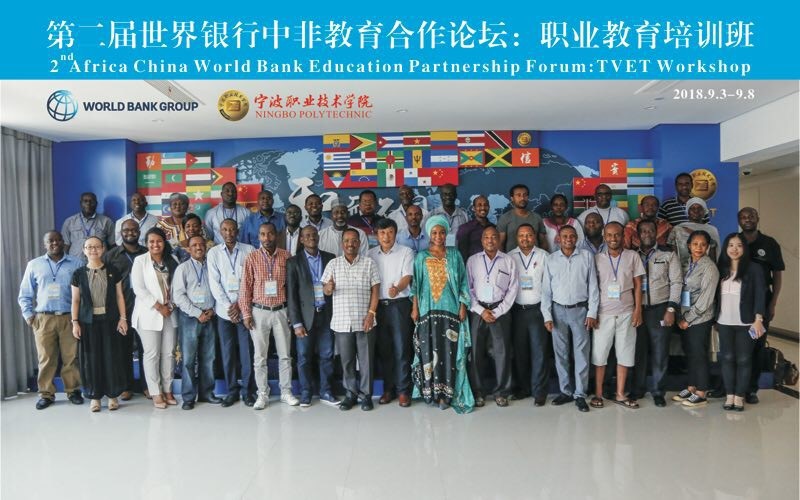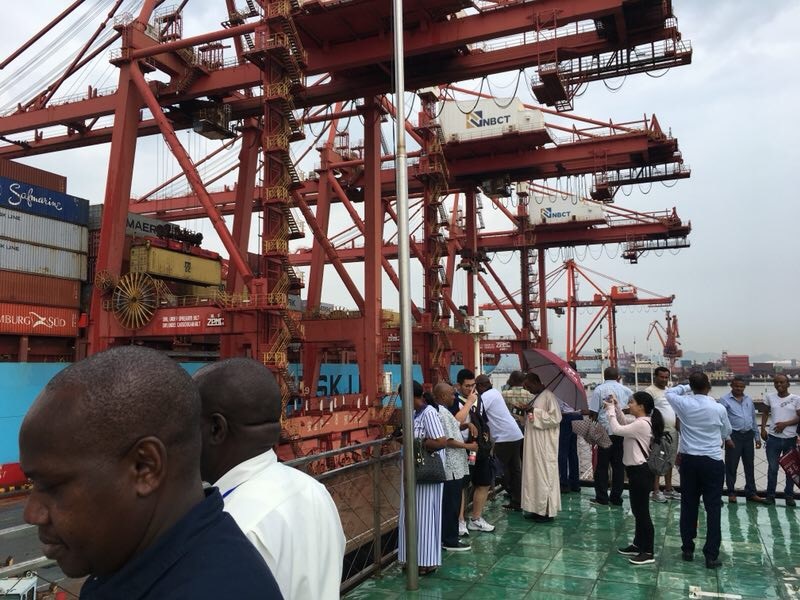
Over the last two decades, Sub-Saharan African countries experienced significant growth as a result of the rapid transformations and foreign investments which helped boost the demand for greater technological skills. But there remains a large challenge as countries continue to observe a large gap in the demand and supply of technical and vocational skills, and industries often identify the shortage of an adequately educated workforce as a major constraint to further growth and development.
Technical and Vocational Education and Training (TVET) in African countries has been under invested and faced considerable challenges, with little enrollment rates, low quality and relevance across most countries. As part of the Partnership for skills in Applied Science, Engineering and Technology (PASET), African countries aim to revitalize the TVET systems with support from the World Bank. From August 31 to September 8, TVET education experts from Africa, China and the World Bank participated in the second Africa China World Bank Education Partnership Forum on TVET, financed by the China World Bank Partnership Facility (CWPF), hosted in Beijing and Ningbo, China. During the Forum, participants learned firsthand of the conducive policy environment as designed by the Chinese government, and the methods and support designed by local government to cultivate interest around TVET to build the necessary skills and practices that help answer real, tangible market demands. Some takeaways from the Chinese model of TVET are as follows:
· A demand-driven TVET system: Skills development at TVET and higher levels is an important component of the massive Chinese education system and has had a profound impact on enhancing national employment and competitiveness. Over the last two decades, the Chinese government has set an overall vision for a “modern” TVET system that is on one hand led by the government but works closely with the productive sector and responds directly to the changing competence needs and qualification requirements in the labor market. The combination of “top down” and “bottom up” approach, in conjunction of the growing economy, has produced remarkable results in the TVET sector. Programs which are less relevant and with lower employment rates are either closed or modified, and new programs which are highly relevant to local industries and have high employment/self-employment rates have been developed with industry involvement. TVET institutions are motivated to work with industries and a multitude of school industry collaboration mechanisms have now been well embedded in the delivery of TVET. Further, TVET institutions are increasingly using technology in the delivery of trainings to meet the demand for a skilled, ‘ICT-capable’ labor force needed by advanced manufacturing technologies. As a result, graduates from vocational colleges find jobs, including self-employment, soon after graduation due to favorable conditions created by China’s rapid industrialization and urbanization. The latest survey by MyCOS[1] indicate that more than 90% of Chinese TVET graduates find gainful employment within 6 months of graduation.
· Quality and relevance: While many skills development systems emphasize the “training” part, the Chinese TVET and skills development (also prevalent in other East Asian countries) integrate “education” and “training” thus promoting both general foundational skills as well as specific technical and vocational education, at secondary and tertiary levels. For technical and practical skills, there is a system of occupational standards, assessment and certification. Training programs and curricula are developed based on the occupational standards that consider specific requirements of a labor market need. Companies are actively involved both in setting standards and in designing curricula. This ensures that vocational colleges produce competent trainees with the necessary skills, knowledge and attitudes relevant to the market. Of particular significance is the fact that the curricula emphasize college-based practical training as well as practical training in an industry setting, combining work and learning together. TVET colleges have a good amount of autonomy in developing institute specific curricular to meet the overall occupational standards set by the Ministry of Human Resources and Social Security and the education standards set by the Ministry of Education. The Ministry of Education (MoE) conducts compliance evaluations on vocational colleges to ensure quality.

· Industry-education cooperation: In China, there is strong cooperation between vocational colleges and enterprises. The TVET institutions are motivated to develop their own brand and produce employable graduates. Companies cooperate with vocational colleges in planning, course development and teaching, allowing students to acquire practical training and industry exposure (apprenticeship), and evaluation of the programs. While local governments provide incentives to companies to encourage such cooperation, the companies themselves feel they have a stake in producing competent and qualified personnel. Competition for skilled labor can be quite fierce in China. Many companies directly entrust local TVET colleges to develop specific training programs and “order” certain number of graduates with specifications. The small and medium size enterprises in particular recognize the value of the TVET faculty and students in R&D solutions to the technical challenges the companies have, hence are enthusiastic in collaboration. The participants witnessed this cooperation during the visit to (i) Ningbo Zhoushan Port Group Col. Ltd, which is among the world’s top five container ports; and (ii) Haitian International Holdings Ltd, a multi-national operation focusing on four industries (plastics machinery, CNC machines, drive and control systems, and die casting machines). Both have very close collaborations with Ningbo Polytechnic.
· TVET Teacher development: In China, as in many other countries, most TVET teachers have only academic qualifications. The government is now incentivizing the teachers to also get skills qualifications themselves, so that all TVET teachers will be “double qualified” with both academic and skills qualifications. For ongoing professional development, teachers in vocational schools are required to undergo two-month of practical training in companies for their career progression and promotion. The practical training at the enterprises equips them with the ability to work with the latest technology and skills for evolving industry needs. Colleges also recruit company experts as part-time teachers for practical courses. Teachers adopt student-centered pedagogy, facilitated by ICT, thus encouraging students to actively engage in and take ownership of their learning experiences. The relentless focus on teaching and instructional excellence also manifest itself at the TVET level.
· Model TVET institutions: While the 9-year basic education is compulsory and publicly provided for free in China, post basic education including senior high, TVET, and higher education is not free. The Chinese government had to prioritize the investment in TVET and higher education. A successful strategy is the development of “model” TVET institutions. In the early 2000s, the Chinese MoE competitively selected 100 model tertiary TVET and 1,000 model secondary TVET schools as national champions for TVET reform and innovations and provided concentrated financial and technical assistance to these institutions. These model institutes were granted policy and financial space to pioneer various mechanisms in school governance, links with industries, and incentives for instructors to promote relevant TVET programs, which are now being scaled up to all TVET providers, both public and private. During the forum, principals of some of these institutions, including Ningbo Polytechnic, Shenzhen Polytechnic, Suzhou Park Institute of Vocational Technology, Yunnan Transport Technician College, and Hangzhou Zhongee Vocational School, shared their experience and success stories. In their view, key factors which enabled their colleges to stand out include demand-orientation, development and constant innovation of ‘niche’ programs based on their comparative advantage and labor market needs, stronger linkage with enterprises, hiring versatile teachers with technical competence and practical experience and exposure to industries, and effective governance and management system.
Looking forward
Currently, as a key flagship program of PASET, the World Bank (WB) is preparing to finance the East Africa Skills for Transformation and Regional Integration Project (EASTRIP) in the next 5- 6 years, supporting a cluster of regional TVET flagship institutions to develop specialized and market relevant technician training in transport, energy, agro-processing, manufacturing, and ICT sectors. A total of 16 regional TVET centers have been selected from Ethiopia, Kenya and Tanzania to receive technical and financial support from the WB, and the project will strengthen their capacity to produce high quality skills for the regional sector markets in railway, highway, port management, energy, light manufacturing, and ICT. The project will also create national TVET enabling environments and enhance regional collaboration.
Despite the differences in economic and industrial context, there are some lessons which EASTRIP countries and TVET institutions could draw from Chinese experience. First, the need to create a national TVET enabling environment, including conductive policy framework and quality assurance mechanisms for TVET to effectively contribute to their economic and industrial transformation. Second, TVET institutions, particularly the flagship institutes, need to institutionalize their linkages with industries; to be forward-looking and adjust their programs to respond to the changing skill needs; use technology in the delivery of training; train their teachers to upgrade their technical knowledge and practical skills and to promote student-centered teaching approach.
With lessons learned from each other and from China’s experience, the participants from EASTRIP countries and TVET institutions would be able to enrich their strategic plans and create a national TVET enabling environment in their respective countries.
[1] MyCOS (My China Occupational Skills) is an education research company in China established in 2006.
